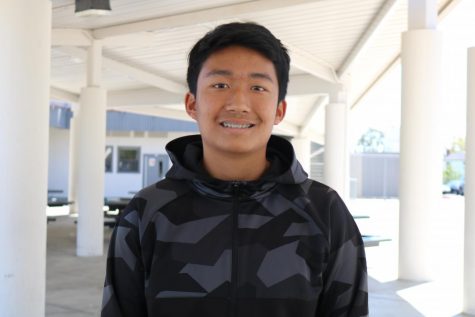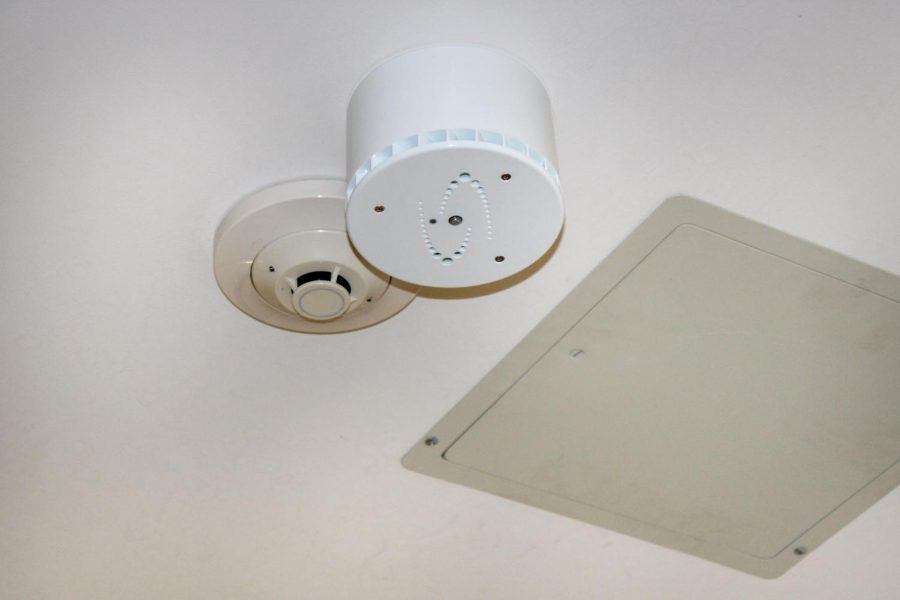School installs vape detectors
A new vape detector, pictured just to the right of a smoke detector, was just installed in the first floor gender neutral bathroom last month to discourage students from vaping.
School administrators are fighting back to prevent vaping in campus bathrooms.
In early November, new vape detectors were installed in three campus bathrooms as part of a pilot program being tested by Cal and Dougherty Valley high schools.
The phase is tested for efficiency and to determine whether more detectors should be added in the future, said Principal Megan Keefer.
“The goal is students’ safety,” Keefer said. “We believe vaping is unsafe and not okay for the student body.”
The pilot phase is supported by the district and funded through a grant from the state’s Tobacco Use Prevention Education program.
A vape detector was installed on the ceiling of the main building’s first floor gender-neutral bathroom and the bathrooms on the side of the world language building. They look similar to smoke detectors and are able to detect certain vapors by their chemical signatures, campus supervisor Chris Torrey said.
Torrey said he and fellow campus supervisor Tim Ford get alerted when the vape detectors are triggered. After the sensor goes off, an alert is transmitted to their phones, allowing them to hopefully catch students in the act of vaping.
But Ford said that the detectors aren’t the most effective because aerosols such as perfume can get picked up by the detectors as well.
“Everyday the detector goes off,” Ford said. “It doesn’t mean we’re going to catch [someone vaping]. They can just spray perfume and it will go off.”
Torrey and Ford said they believe the vape detectors can be good deterrents and will help the growing problem on campus. But they also believe students must take the self-initiative to stop.
“Kids have to want to stop,” Torrey said. “It’s on the kids. The detectors can’t do everything.”
Many students are aware of the vaping problem, but some do not know about the new vape detector’s installation.
“I see kids vaping almost every time I go into the bathroom,” junior Kimi Shirai said.
Shirai believes the vape detectors could be helpful, but only if they’re enforced.
One issue with the new system is that administrators may be unable to tell who, or what, set off the vape detectors. If an administrator is unable to arrive promptly, the culprit could be long gone.
Especially in the crowded gender-neutral bathroom, it may be difficult to pinpoint who set off the alarm, which makes enforcement difficult.
In fact, some students who vape reported that the new detector seems pointless. A junior boy, who wished to remain anonymous because he vapes at school, was aware of the detectors. But he believes that they would not be a good deterrent.
“I think kids are going to do all that other [expletive] anyway,” he said.
On the other hand, a sophomore boy who vapes said that detectors may be effective in reducing the number of students who vape on campus.
“It matters that they’re in the back [of the bathroom],” he said. “It’s a risk factor. People tend to stay out of the area,” he said.
One way students who vape can circumvent the detectors is by “zeroing” vapor. By inhaling and waiting for the vapor to dissipate, students can reduce the likelihood of the detectors picking up any signals.
The general sentiment of Cal students ’s is that the detectors are easily fooled and ineffective, seeming to indicate that the vaping problem is unlikely to halt.
AP U.S. History teacher Troy Bristol believes that students vape because of social standards, which a detector is unlikely to change.
“I think students vape for the sake of being cool, trying to be teens beyond peer pressure” Bristol said.
Shirai, on the other hand, believes that kids vape to relieve stress.
With so many different opinions on why kids vape and the dangers of vaping in general, it’s hard to see how the school can craft a solution.
But since students may not be discouraged by the vape detectors, the logistical issues of using alerts to apprehend them may outweigh the positives and indicate that the new alarm system is not as effective as administrators had hoped.
“The vape detectors won’t really discourage anyone from doing it,” a junior boy said.
Instead, he believes education is how school can help students with their addiction.
“I think the school could inform students about nic patches and gum,” he said.

Anthony Austria is a sophomore and is serving as a photographer for the Californian. Besides photography, he enjoys biking around town with his friends...





